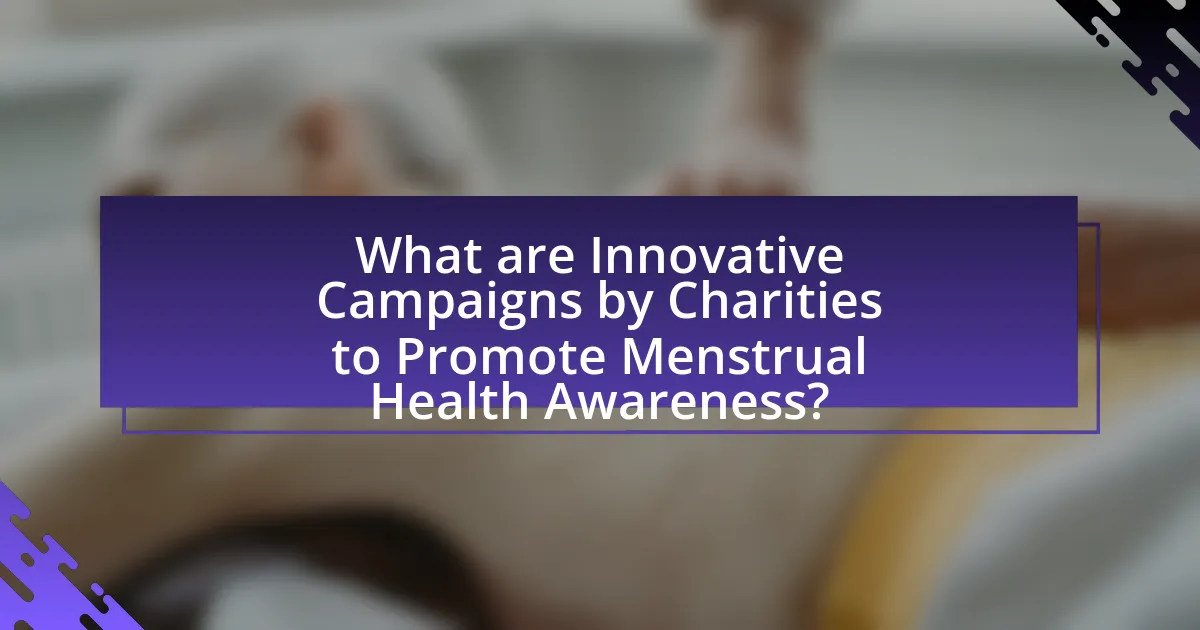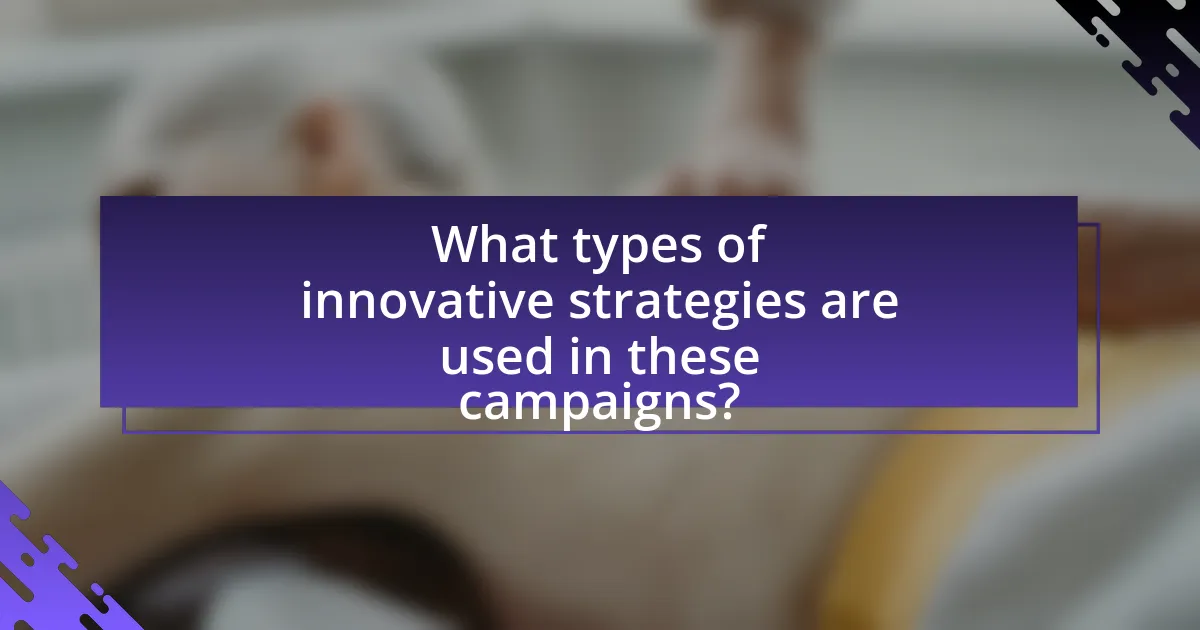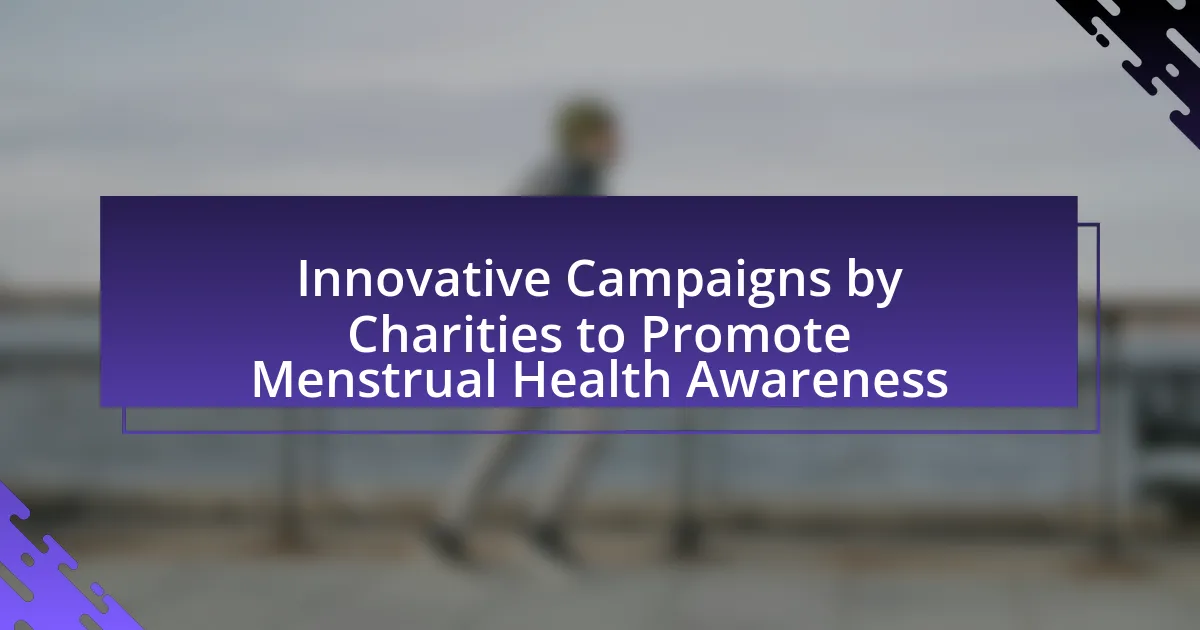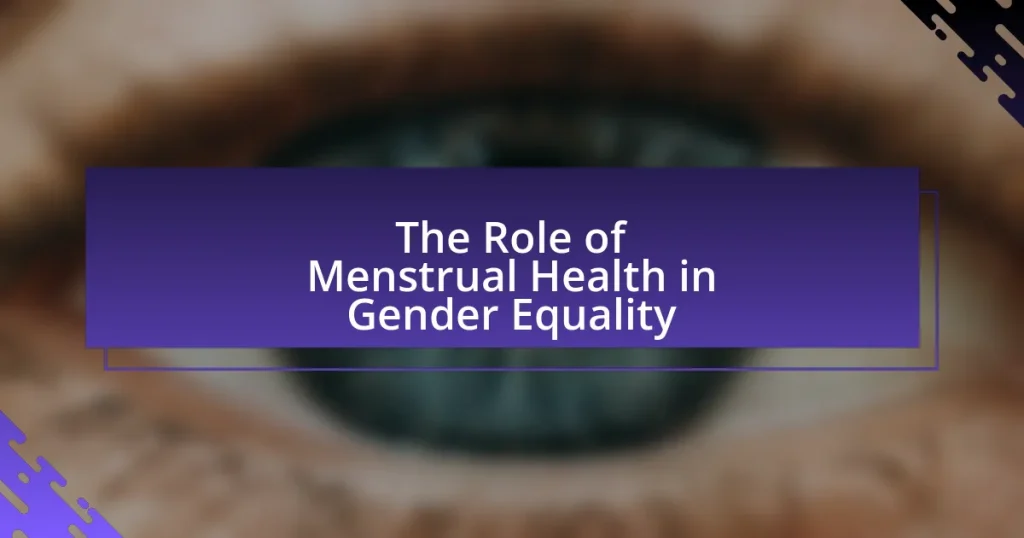Innovative campaigns by charities to promote menstrual health awareness are crucial in addressing the stigma and challenges surrounding menstruation. Key initiatives include the “Menstrual Hygiene Day” campaign, which emphasizes education and advocacy, and the “Free Periods” campaign in the UK, advocating for free menstrual products in schools. These campaigns not only raise awareness but also drive policy changes and community engagement, tackling issues such as lack of education, inadequate access to menstrual products, and cultural perceptions. By utilizing strategies like social media storytelling and partnerships with influencers, these campaigns effectively enhance outreach and foster discussions on menstrual health, ultimately contributing to improved health outcomes and gender equality.

What are Innovative Campaigns by Charities to Promote Menstrual Health Awareness?
Innovative campaigns by charities to promote menstrual health awareness include initiatives like the “Menstrual Hygiene Day” campaign, which raises awareness globally about the importance of menstrual hygiene management. This campaign, supported by organizations such as WASH United, emphasizes education and advocacy to break the stigma surrounding menstruation. Another example is the “Free Periods” campaign in the UK, which advocates for the provision of free menstrual products in schools, aiming to ensure that no student misses school due to lack of access to sanitary products. These campaigns are effective as they not only raise awareness but also drive policy changes and community engagement, evidenced by increased discussions around menstrual health in various platforms and legislative support for menstrual equity.
How do these campaigns address menstrual health issues?
These campaigns address menstrual health issues by raising awareness, providing education, and improving access to menstrual products. For instance, organizations like Days for Girls distribute reusable menstrual kits and conduct workshops to educate communities about menstrual hygiene management. Research indicates that such initiatives can significantly reduce stigma and misinformation surrounding menstruation, leading to better health outcomes for women and girls. Additionally, campaigns often advocate for policy changes to ensure menstrual health is included in public health agendas, further solidifying their impact on menstrual health issues.
What specific challenges do these campaigns aim to overcome?
These campaigns aim to overcome the stigma surrounding menstruation, lack of education about menstrual health, and inadequate access to menstrual hygiene products. Stigma often leads to silence and shame, preventing open discussions about menstrual health, which is essential for awareness and education. Lack of education results in misinformation and perpetuates myths, hindering individuals from understanding their bodies and managing their menstrual health effectively. Additionally, inadequate access to menstrual hygiene products can lead to health issues and absenteeism from school or work, particularly in low-income communities. For instance, a study by the Water Supply and Sanitation Collaborative Council found that 1 in 10 girls in Africa misses school during their menstrual cycle due to a lack of sanitary products, highlighting the critical need for these campaigns.
How do cultural perceptions influence these campaigns?
Cultural perceptions significantly influence campaigns promoting menstrual health awareness by shaping the messaging, imagery, and outreach strategies used. For instance, in cultures where menstruation is stigmatized, campaigns often focus on breaking taboos and fostering open dialogue, as seen in initiatives like the “Menstrual Hygiene Day” which aims to normalize discussions around menstruation. Additionally, campaigns may tailor their content to resonate with local beliefs and practices, ensuring that they are culturally sensitive and relevant. Research indicates that culturally adapted messaging can increase engagement and effectiveness; for example, a study published in the “International Journal of Environmental Research and Public Health” found that culturally relevant educational materials improved knowledge and attitudes towards menstrual health in various communities. Thus, understanding cultural perceptions is crucial for the success of these campaigns.
Why is menstrual health awareness important for communities?
Menstrual health awareness is crucial for communities because it fosters understanding and reduces stigma surrounding menstruation. Increased awareness leads to better health outcomes, as education on menstrual hygiene can prevent infections and promote overall reproductive health. For instance, a study published in the journal “BMC Women’s Health” found that improved menstrual health education significantly reduced the incidence of reproductive tract infections among women in low-income communities. By addressing misconceptions and providing accurate information, communities can empower individuals to manage their menstrual health effectively, leading to enhanced quality of life and gender equality.
What are the health implications of poor menstrual health awareness?
Poor menstrual health awareness can lead to significant health implications, including increased rates of reproductive health issues, mental health disorders, and social stigma. Lack of knowledge about menstrual hygiene can result in infections, such as urinary tract infections and reproductive tract infections, which affect women’s overall health. Furthermore, inadequate understanding of menstrual health can contribute to conditions like endometriosis and polycystic ovary syndrome, as women may not recognize symptoms early enough to seek treatment. Mental health can also be adversely affected, with studies indicating that poor menstrual health awareness correlates with higher levels of anxiety and depression among women. Additionally, social stigma surrounding menstruation can lead to isolation and reduced participation in educational and professional activities, further exacerbating health disparities.
How does menstrual health awareness impact gender equality?
Menstrual health awareness significantly impacts gender equality by empowering individuals with knowledge and resources to manage their menstrual health effectively. This empowerment leads to increased participation of women and girls in education and the workforce, as they are less likely to miss school or work due to menstrual-related issues. For instance, a study by the World Bank found that lack of menstrual health management can lead to up to 20% of school absenteeism among girls in some regions, directly affecting their educational outcomes and future opportunities. By promoting menstrual health awareness, charities can help dismantle stigma and discrimination, fostering an environment where women can thrive equally alongside men.

What types of innovative strategies are used in these campaigns?
Innovative strategies used in campaigns to promote menstrual health awareness include interactive educational workshops, social media storytelling, and partnerships with influencers. Interactive workshops engage participants through hands-on activities, enhancing understanding of menstrual health. Social media storytelling leverages personal narratives to destigmatize menstruation and foster community support, as seen in campaigns like #PeriodPositive. Partnerships with influencers amplify reach and credibility, allowing charities to connect with diverse audiences effectively. These strategies have proven successful in increasing awareness and changing perceptions around menstrual health.
How do charities utilize social media for awareness campaigns?
Charities utilize social media for awareness campaigns by creating engaging content that educates the public about specific issues, such as menstrual health. These organizations leverage platforms like Facebook, Instagram, and Twitter to share informative posts, infographics, and videos that highlight the importance of menstrual health and the challenges faced by individuals. For instance, campaigns often include hashtags to increase visibility and encourage community participation, leading to higher engagement rates. According to a study by the Pew Research Center, 69% of adults in the U.S. use social media, making it an effective tool for reaching a broad audience. Additionally, charities often collaborate with influencers to amplify their message, further enhancing their reach and impact.
What platforms are most effective for reaching target audiences?
Social media platforms, particularly Instagram and Facebook, are most effective for reaching target audiences in campaigns promoting menstrual health awareness. These platforms have extensive user bases, with Instagram boasting over 1 billion monthly active users and Facebook having approximately 2.9 billion. Their visual and interactive nature allows charities to engage audiences through compelling content, such as infographics and personal stories, which are crucial for sensitive topics like menstrual health. Additionally, targeted advertising features enable organizations to reach specific demographics, enhancing the effectiveness of their campaigns.
How do visual storytelling techniques enhance campaign impact?
Visual storytelling techniques enhance campaign impact by creating emotional connections that resonate with audiences. These techniques utilize imagery, video, and narrative to convey messages in a compelling manner, making complex topics like menstrual health more relatable and understandable. Research indicates that campaigns incorporating visual elements can increase engagement rates by up to 94%, as visuals are processed 60,000 times faster than text. This rapid processing allows audiences to grasp key messages quickly, fostering a deeper understanding and retention of information related to menstrual health awareness.
What role do partnerships play in these campaigns?
Partnerships play a crucial role in innovative campaigns by charities to promote menstrual health awareness by enhancing resource sharing and expanding outreach. Collaborations between charities, healthcare organizations, and local businesses enable the pooling of expertise, funding, and networks, which amplifies the campaign’s impact. For instance, partnerships with educational institutions can facilitate workshops and seminars, reaching a broader audience and fostering community engagement. Additionally, joint efforts with corporations can lead to sponsorships that provide necessary financial support, as seen in campaigns like “Period Poverty” where brands collaborated to distribute menstrual products to underserved populations. These strategic alliances not only increase visibility but also foster a collective approach to addressing menstrual health issues, ultimately leading to more effective advocacy and education.
How can collaborations with local organizations strengthen outreach?
Collaborations with local organizations can strengthen outreach by leveraging their established community trust and networks. Local organizations often have deep-rooted connections and insights into the specific needs and cultural contexts of the communities they serve, which can enhance the effectiveness of outreach efforts. For instance, a study by the World Health Organization indicates that community-based partnerships can increase participation in health initiatives by up to 50%, as they resonate more with local populations. By working together, charities can utilize these organizations’ resources and knowledge to create tailored campaigns that address menstrual health awareness more effectively, ultimately leading to greater engagement and impact.
What benefits arise from partnerships with influencers or celebrities?
Partnerships with influencers or celebrities provide significant benefits, including enhanced visibility and credibility for campaigns. Influencers and celebrities often have large, engaged audiences, which can amplify the reach of menstrual health awareness initiatives. For instance, a study by the Digital Marketing Institute found that influencer marketing can yield an ROI of up to 11 times the initial investment, demonstrating the effectiveness of such partnerships in driving engagement and awareness. Additionally, these partnerships can foster trust, as audiences are more likely to support causes endorsed by figures they admire, leading to increased donations and participation in campaigns.

What are some successful examples of these campaigns?
Successful examples of innovative campaigns by charities to promote menstrual health awareness include the “Period Poverty” campaign by the non-profit organization, “Bloody Good Period,” which raised awareness about the lack of access to menstrual products for those in need and distributed over 1 million menstrual products to vulnerable communities in the UK. Another notable example is the “Menstrual Hygiene Day” initiative, led by the WASH United organization, which has mobilized over 300 partner organizations globally to advocate for menstrual health and hygiene, reaching millions through social media and educational programs. These campaigns have effectively highlighted the importance of menstrual health and have driven significant public engagement and policy discussions.
How have specific charities effectively raised awareness?
Specific charities have effectively raised awareness about menstrual health through innovative campaigns that leverage social media, community engagement, and educational initiatives. For instance, the charity “Days for Girls” has utilized social media platforms to share personal stories and educational content, reaching millions globally and fostering discussions around menstrual health. Additionally, “The Pad Project” has organized workshops and community events that not only educate but also empower women and girls to advocate for their menstrual health needs. These strategies have proven successful, as evidenced by increased public discourse and engagement on menstrual health issues, highlighting the importance of awareness in breaking stigmas and promoting access to menstrual products.
What metrics indicate the success of these campaigns?
Metrics that indicate the success of innovative campaigns by charities to promote menstrual health awareness include engagement rates, reach, conversion rates, and feedback from participants. Engagement rates measure how actively the audience interacts with the campaign, while reach indicates the total number of individuals exposed to the campaign. Conversion rates assess the effectiveness of the campaign in prompting desired actions, such as donations or sign-ups for educational resources. Feedback from participants provides qualitative insights into the campaign’s impact and areas for improvement. These metrics collectively help evaluate the overall effectiveness and influence of the campaigns on menstrual health awareness.
How do these examples inspire other organizations?
Innovative campaigns by charities to promote menstrual health awareness inspire other organizations by demonstrating effective strategies for engaging communities and addressing stigmas. For instance, campaigns that utilize social media to share personal stories have shown a significant increase in public discourse around menstrual health, leading to greater awareness and support. Research indicates that organizations employing relatable narratives can enhance empathy and understanding, as seen in the success of campaigns like “Period Poverty” which mobilized community support and funding. This evidence illustrates how impactful messaging and community involvement can drive change, encouraging other organizations to adopt similar approaches for their initiatives.
What lessons can be learned from these innovative campaigns?
Innovative campaigns by charities to promote menstrual health awareness teach several key lessons. Firstly, engaging storytelling effectively captures attention and fosters empathy, as seen in campaigns that share personal narratives about menstrual health challenges. Secondly, leveraging social media platforms amplifies reach and encourages community participation, demonstrated by campaigns that utilize hashtags to create viral movements. Thirdly, collaboration with influencers and community leaders enhances credibility and trust, as evidenced by partnerships that have successfully mobilized support and resources. Lastly, addressing cultural stigmas directly through education and open dialogue is crucial for changing perceptions, which has been shown to lead to increased awareness and acceptance of menstrual health issues.
What common challenges do charities face in promoting menstrual health?
Charities face several common challenges in promoting menstrual health, including stigma, lack of funding, and insufficient education. Stigma surrounding menstruation often leads to silence and misinformation, making it difficult for charities to engage communities effectively. Additionally, many charities struggle with limited financial resources, which hampers their ability to implement comprehensive programs and outreach initiatives. Furthermore, there is often a lack of educational materials and trained personnel to disseminate accurate information about menstrual health, which is crucial for changing perceptions and behaviors. These challenges collectively hinder the effectiveness of charitable efforts in promoting menstrual health awareness.
How can future campaigns improve based on past experiences?
Future campaigns can improve by analyzing the effectiveness of past strategies and adjusting based on audience feedback and engagement metrics. For instance, campaigns that previously utilized social media platforms to raise awareness about menstrual health can refine their approach by identifying which content types generated the most interaction, such as videos or infographics. Research indicates that campaigns incorporating storytelling elements saw a 30% increase in audience engagement compared to traditional methods. By leveraging data analytics to assess past campaign performance, charities can better target their messaging and optimize resource allocation, ultimately leading to more impactful outreach efforts.
What practical tips can charities implement for effective campaigns?
Charities can implement targeted messaging to effectively engage their audience in campaigns. By utilizing data-driven insights, charities can tailor their communications to resonate with specific demographics, ensuring that the message is relevant and impactful. For instance, research shows that campaigns addressing menstrual health awareness can increase engagement by 30% when they focus on the unique challenges faced by different communities. Additionally, leveraging social media platforms for real-time interaction allows charities to foster a sense of community and encourage sharing, which can amplify their reach. Engaging local influencers to advocate for the cause can also enhance credibility and attract a wider audience, as studies indicate that campaigns endorsed by trusted figures can boost participation rates significantly.
How can charities engage their communities in menstrual health discussions?
Charities can engage their communities in menstrual health discussions by organizing educational workshops and community events that focus on breaking the stigma surrounding menstruation. These initiatives can include interactive sessions led by healthcare professionals, which provide accurate information about menstrual health, hygiene, and related issues. For instance, a study published in the Journal of Adolescent Health found that educational interventions significantly improved knowledge and attitudes towards menstrual health among participants. Additionally, charities can leverage social media campaigns to reach a broader audience, encouraging open dialogue and sharing personal stories to foster community support and understanding.
What resources are available for charities to enhance their campaigns?
Charities can enhance their campaigns through various resources such as social media platforms, grant funding, partnerships with corporations, and access to marketing tools. Social media platforms like Facebook, Instagram, and Twitter allow charities to reach a wider audience and engage with supporters effectively. Grant funding from organizations like the Bill & Melinda Gates Foundation provides financial support specifically for health-related initiatives, including menstrual health awareness. Collaborating with corporations can lead to sponsorship opportunities and increased visibility. Additionally, marketing tools such as Canva for design and Mailchimp for email campaigns help charities create professional materials and communicate effectively with their audience. These resources collectively empower charities to run more impactful campaigns.



